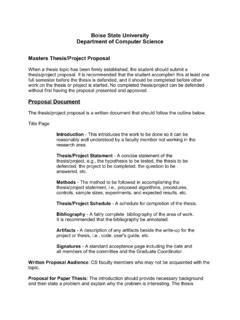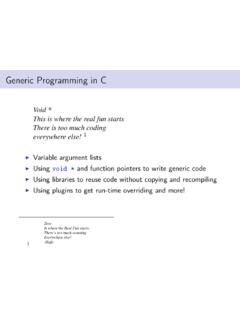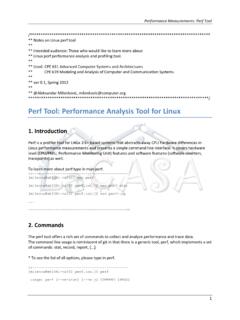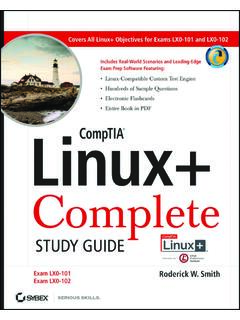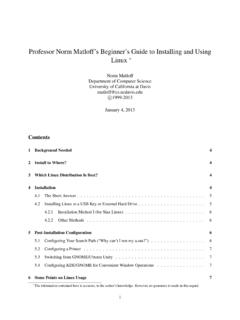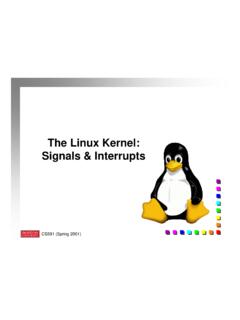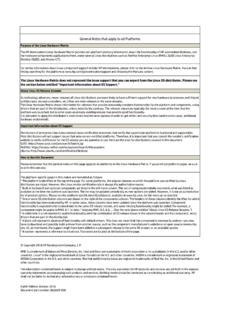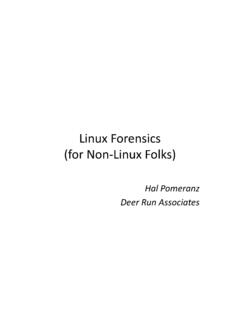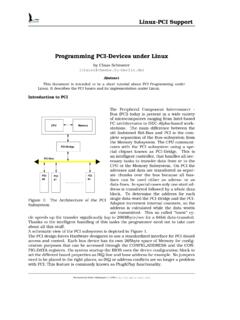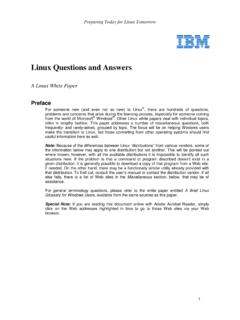Transcription of Process Scheduling in Linux
1 '&$% Process Scheduling in Linux Scheduling Mechanism: how to switch. Scheduling Policy: when to switch and what Process to choose. Some schedul-ing objectives: fast Process response time avoidance of Process starvation good throughput for background jobs support for soft real time processes Linux uses dynamically assigned Process priorities for non real-time running for a long time have their priorities decreased while pro-cesses that are waiting have their priorities increased dynamically.'&$%Classification of Processes Compute-boundversusI/O bound. Linux implicitly favors I/O bound pro-cesses over compute bound processes (why?). Another classification: Interactive : shells, text editors, GUI applications.
2 Batch : compilers, database search engine, web server,number-crunching. Real-time applications, data-collection from physi-cal sensors, robot controllers.'&$% Process States in LinuxThere are five Process states defined in/usr/include/ #define TASK_RUNNING 0#define TASK_INTERRUPTIBLE 1#define TASK_UNINTERRUPTIBLE 2#define TASK_ZOMBIE 4#define TASK_STOPPED 8'&$%'&$% Scheduling Parameters Processes are preemptible in user mode but not in kernel mode. How long is aquantum? ExamineINITTASK macro ininclude/ file. All processes inherit the default quantum value via fork from theinittask.#define DEF_COUNTER (10*HZ/100) /* 100 ms time slice */#define MAX_COUNTER (20*HZ/100)#define DEF_NICE (0) Processes have two types of priorities: Static 1 and 99.
3 Used by real-time processes. Dynamic non real-time processes. Sum of the base time quantumand of the number of ticks of CPU time left to the Process before its quantumexpiers in the current epoch.'&$%Data Structures Used by SchedulerFrom thetaskstructininclude/ task_struct {..volatile long need_resched;..long counter;long nice; // replaces the priority variable in earlier kernelunsigned long policy; //SCHED_OTHER, SCHED_FIFO, has_cpu, processor;unsigned long cpus_allowed;..unsigned long rt_priority;..}'&$%Passing quantums after fork()From thedofork(..)function from do_fork in (different from the textbook)p->counter = (current->counter + 1) >> 1;current->counter >>= 1;if (!current->counter)current->need_resched = 1; The number of ticks left to the parent is split in two halves, one for the parent,one for the child.
4 This prevents processes from getting an unlimited amountof CPU time.'&$%Invoking the schedulerThe scheduler proper is the functionschedule() Direct : A Process must be blocked because a resourceis not available, a device driver can invokeschedule()directly if it will beexecuting a long iterative task. Lazy setting theneedreschedflag field ofcurrentto : Whencurrenthas use up its quantum of CPU time (done byupdateprocesstimesfunction ) When a Process is woken up and its priority is higher than that of thecurrentprocess. When asetscheduler()orschedyield()system call is issued.'&$%Goodness of a ProcessThis is the function that decides how desirable a Process You can weighdifferent processes against each other depending on what CPU they ve run onlately etc to try to handle cache and TLB miss values: -1000: never select this 0: out of time, recalculate counters (but it might still be selected) +ve: goodness value (the larger, the better) +1000: realtime Process , select this.
5 '&$%Actions performed by schedule() treat current Process select Process switch Process '&$% Linux SMP scheduler Each cpu runs the schdule function on its own and communicate via shareddata ** We align per-CPU Scheduling data on cacheline boundaries,* to prevent cacheline ping-pong.*/static union {struct schedule_data {struct task_struct * curr;cycles_t last_schedule;} schedule_data;char __pad [SMP_CACHE_BYTES];} aligned_data [NR_CPUS] __cacheline_aligned = { {{&init_task,0}}}; Processor affinity is implemented through extra goodness for staying on thesame cpu.'&$%Performance of Linux Scheduler The Scheduling algorithm does not scale well. The predefined quantum is too large for high system loads. I/O bound Process priority boosting is not optimal.
6 Support for real-time applications is attempts have been made to provide alternate schedulers. An interestingtool called Lockmeter is available to study performance of SMP Scheduling .'&$%System Calls Related to SchedulingNamenice()getpriority()setprio rity()schedgetscheduler()schedsetschedul er()schedgetparam()schedsetparam()schedy ield()schedgetprioritymin()schedgetprior itymax()schedrrgetinterval()
